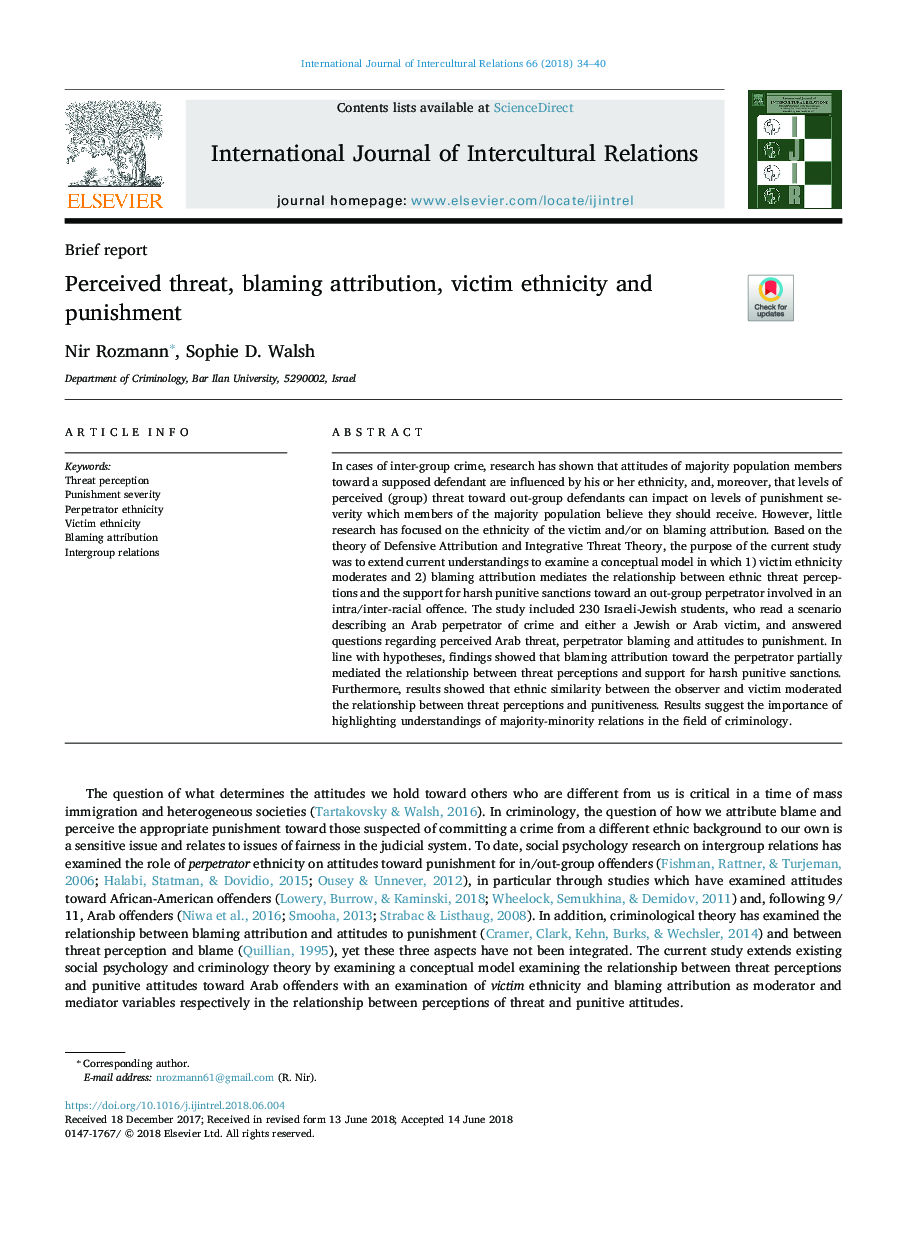| کد مقاله | کد نشریه | سال انتشار | مقاله انگلیسی | نسخه تمام متن |
|---|---|---|---|---|
| 7323600 | 1475724 | 2018 | 7 صفحه PDF | دانلود رایگان |
عنوان انگلیسی مقاله ISI
Perceived threat, blaming attribution, victim ethnicity and punishment
ترجمه فارسی عنوان
تهدید درک شده، سرزنش ارجاع، قومیت و مجازات قربانی
دانلود مقاله + سفارش ترجمه
دانلود مقاله ISI انگلیسی
رایگان برای ایرانیان
کلمات کلیدی
درک تهدید، شدت مجازات، قومیت مرتکب، قومیت قربانی، سرزنش ارجاع، روابط میان گروهی،
ترجمه چکیده
در موارد جرم بین گروهی، تحقیقات نشان داده است که نگرش اعضای اکثریت جمعیت نسبت به متهمین احتمالی تحت تأثیر قومی قرار دارد و علاوه بر این، سطح تهدید درک شده (گروهی) نسبت به متهمین خارج از گروه میتواند روی سطوح تاثیر بگذارد از شدت مجازات که اعضای اکثریت جمعیت معتقدند باید دریافت کنند. با این حال، تحقیقات کمی بر قومیت قربانی و / یا سرزنش ارجاع متمرکز شده است. بر اساس نظریه تخصیص دفاع و تئوری تهدید یکپارچه، هدف مطالعه حاضر، گسترش تفاهم فعلی به منظور بررسی یک مدل مفهومی است که در آن: 1) قومیت قربانی را تعدیل می کند و 2) تبیین رابطه، میان روابط میان ادراک تهدید قومی و حمایت برای اعمال تحریم های سختگیرانه علیه یکی از اعضای گروهی که درگیر یک جرم درون / نژادی است. این مطالعه شامل 230 دانشجوی یهودی یهودی بود که یک سناریو را به عنوان یک عامل جنایتکار در عربستان و یکی از قربانیان یهودی یا عرب توصیف کرد و به پرسش های مربوط به تهدید عرب درک شده، سوء رفتار مرتکبان و نگرش به مجازات پاسخ داد. با توجه به فرضیه ها، یافته ها نشان داد که تقصیر دادن نسبت به مجرمان، بخشی از رابطه بین ادراکات تهدید و حمایت از تحریم های شدید مجازات است. علاوه بر این، نتایج نشان داد که شباهت قومی بین ناظر و قربانی رابطه بین ادراکات تهدید و مجازات را تعدیل می کند. نتایج نشان می دهد اهمیت برجسته کردن درک روابط اکثریت و اقلیت در زمینه جرم شناسی.
موضوعات مرتبط
علوم انسانی و اجتماعی
مدیریت، کسب و کار و حسابداری
کسب و کار و مدیریت بین المللی
چکیده انگلیسی
In cases of inter-group crime, research has shown that attitudes of majority population members toward a supposed defendant are influenced by his or her ethnicity, and, moreover, that levels of perceived (group) threat toward out-group defendants can impact on levels of punishment severity which members of the majority population believe they should receive. However, little research has focused on the ethnicity of the victim and/or on blaming attribution. Based on the theory of Defensive Attribution and Integrative Threat Theory, the purpose of the current study was to extend current understandings to examine a conceptual model in which 1) victim ethnicity moderates and 2) blaming attribution mediates the relationship between ethnic threat perceptions and the support for harsh punitive sanctions toward an out-group perpetrator involved in an intra/inter-racial offence. The study included 230 Israeli-Jewish students, who read a scenario describing an Arab perpetrator of crime and either a Jewish or Arab victim, and answered questions regarding perceived Arab threat, perpetrator blaming and attitudes to punishment. In line with hypotheses, findings showed that blaming attribution toward the perpetrator partially mediated the relationship between threat perceptions and support for harsh punitive sanctions. Furthermore, results showed that ethnic similarity between the observer and victim moderated the relationship between threat perceptions and punitiveness. Results suggest the importance of highlighting understandings of majority-minority relations in the field of criminology.
ناشر
Database: Elsevier - ScienceDirect (ساینس دایرکت)
Journal: International Journal of Intercultural Relations - Volume 66, September 2018, Pages 34-40
Journal: International Journal of Intercultural Relations - Volume 66, September 2018, Pages 34-40
نویسندگان
Nir Rozmann, Sophie D. Walsh,
